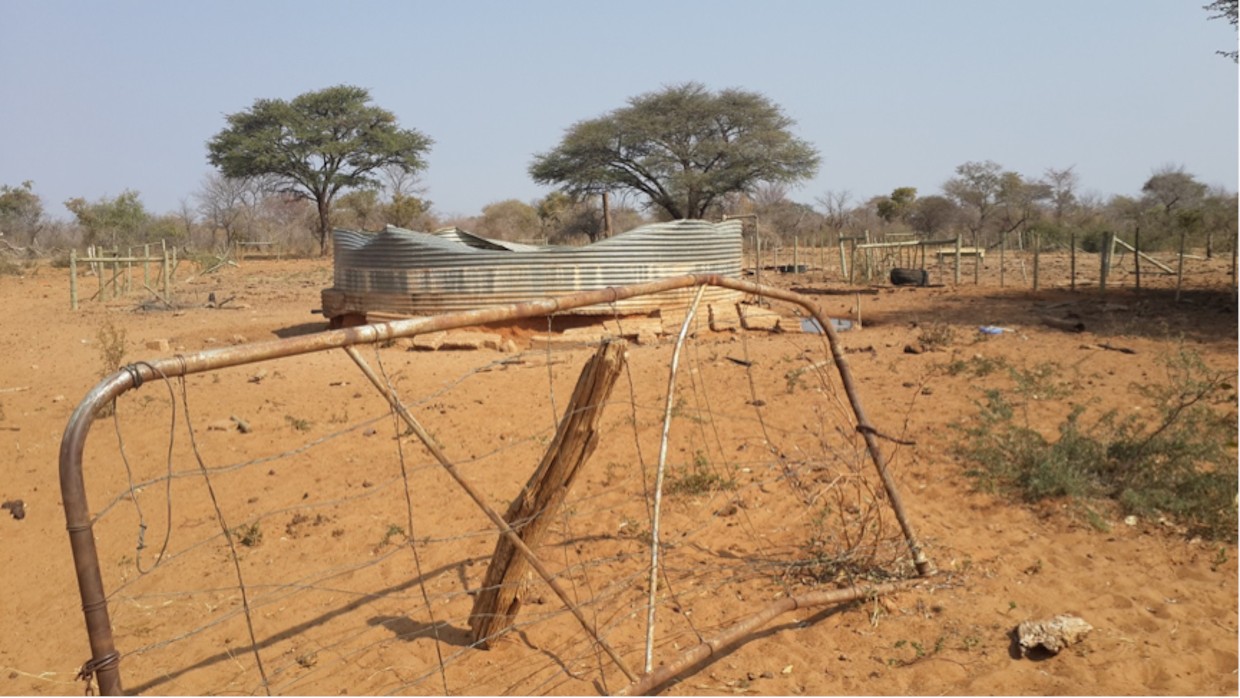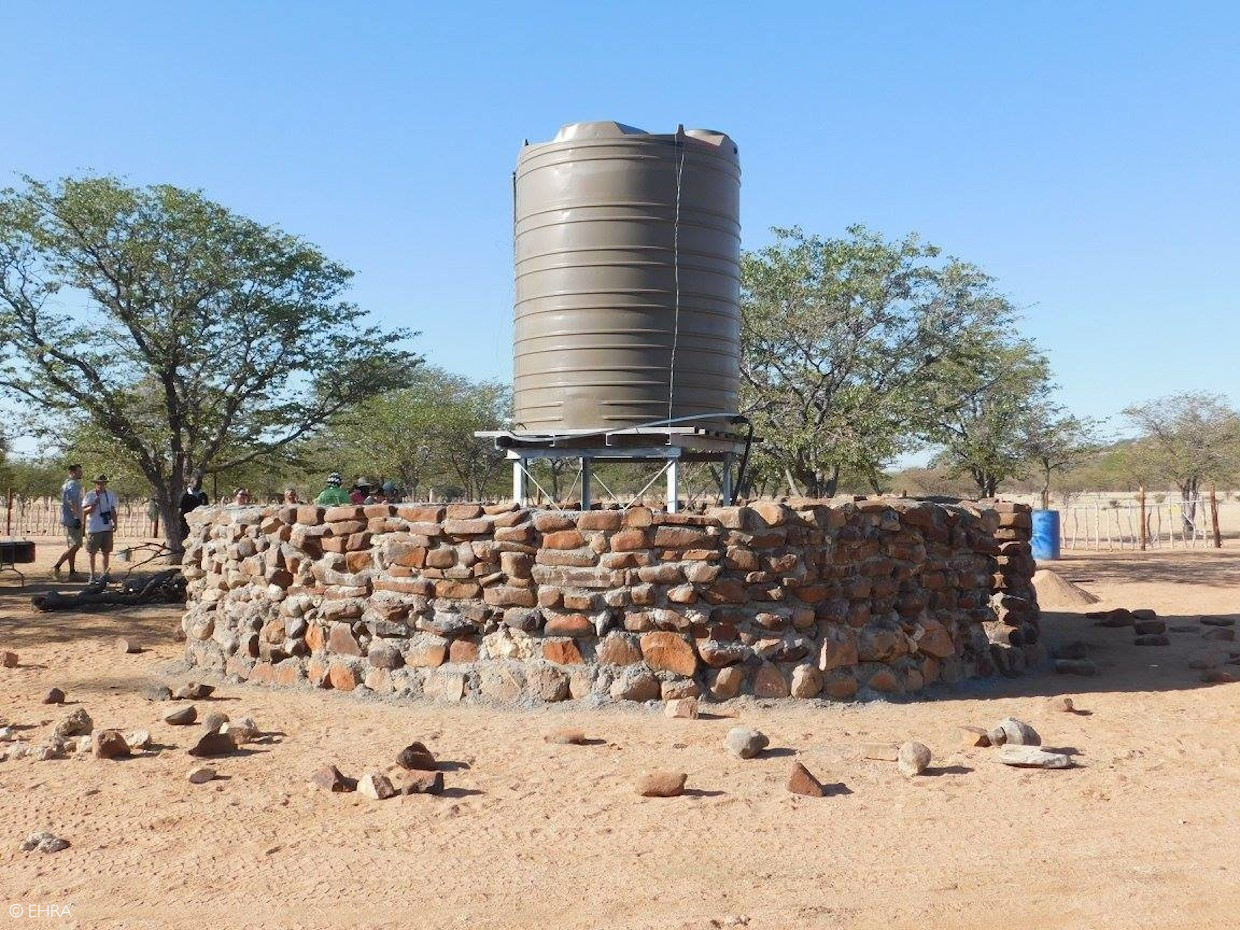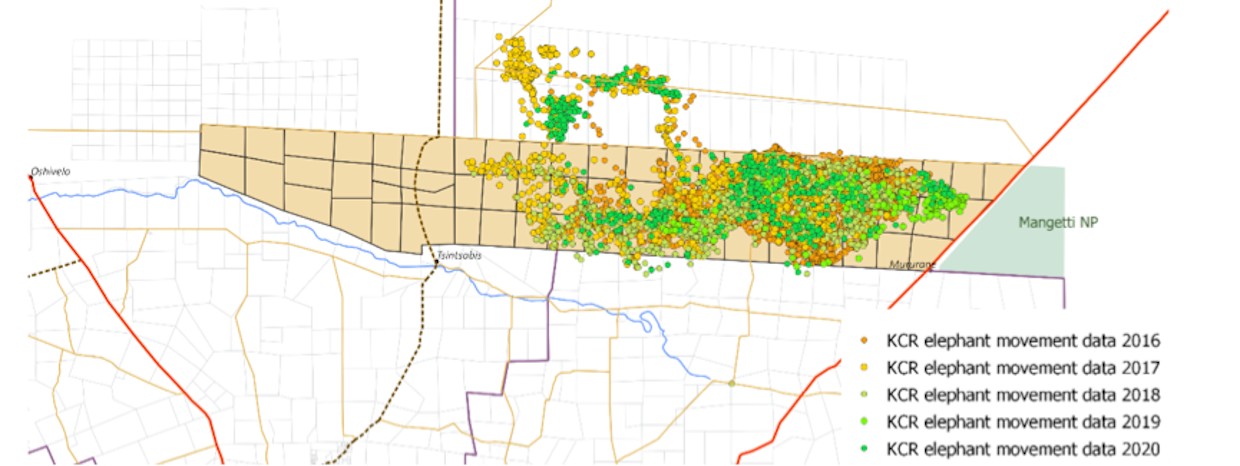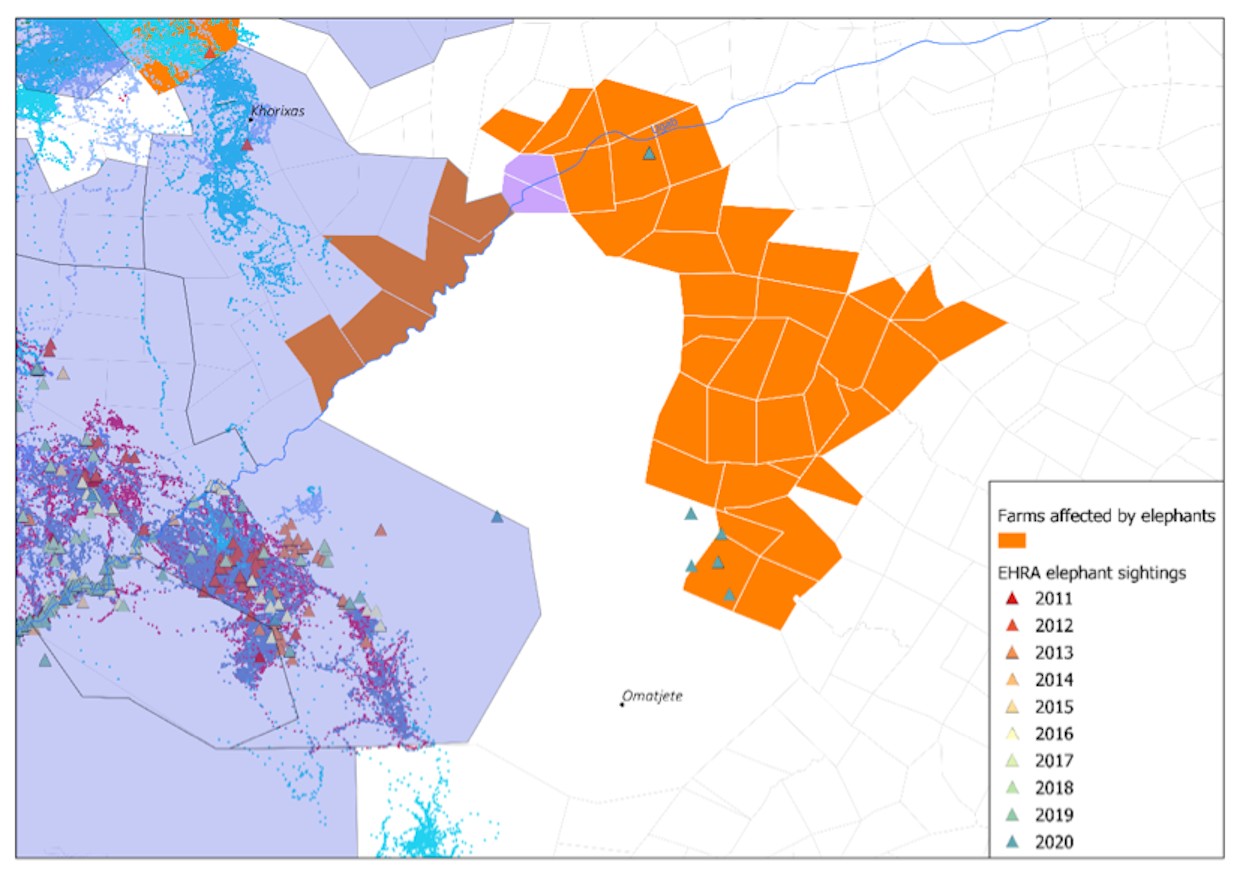
This article was originally published on the Conservation Namibia website
The recent decision by the Namibian government to sell 170 elephants has been met with public outcries, media articles full of unsubstantiated accusations and considerable confusion. In order to judge why this decision was taken and what other options could be available for these elephants, we need to consider the historical and current context, rather than simply assume the worst of the accusations to be true.
Towards the end of 2020, the Ministry of Environment, Forestry and Tourism (MEFT) announced their intention to sell a total of 170 elephants[1] from four different locations in Namibia (see map below). The stated reasons for the sale were increased human-elephant conflict[2] in the four areas, which has been exacerbated by the recent drought. In each area, the elephants to be taken were entire family groups (i.e. females and young) plus a few bulls. Those wanting to buy these elephants had to employ qualified Namibian game capture teams and move them to a suitably fenced private reserve in Namibia, or if they wanted to export them to another country, adhere to all CITES export and import requirements.

The important points to note from the tender advert are MEFT’s insistence on taking whole family groups (rather than individuals) and their concern that the buyer and destination abide by national and international law. The requirements set forth here would weed out the unscrupulous buyers who would prefer to take young individual elephants that can be tamed (or broken) for the purposes of human entertainment. The requirements for proper fencing in Namibia are likely to ensure that the elephants do not simply start causing conflict in other areas of the country, or return to the capture location.
There are some details left out of the tender advert that are nonetheless crucial to understanding the thinking behind the decision. I have obtained a draft copy of a document called “An Overview of Elephant Conservation and Management in Namibia” that accompanies the Draft National Elephant Management Plan. This document details all of MEFT’s recent public consultations, past and present elephant research and monitoring, and approaches to reducing human-elephant conflict by MEFT and non-governmental organisations. The information contained in this extensive document (commissioned by MEFT, but prepared by an independent consultant) provides valuable insight into the reasoning behind MEFT’s intention to sell 170 elephants.
Understanding the historical context
The history of elephants in Namibia, as with most things in Africa, is tied up with the history of colonialism, war and land development. Rock art engravings reveal that elephants occurred throughout the country before waves of colonisers eradicated almost all of them in the southern half of the country during the 1800’s. The remaining elephants in the more remote northern regions were killed in high numbers by the South African military, colonisers, and local people in the mid- to late-1900’s. Severe drought in the north-west during the 70’s and 80’s added to the elephants’ woes in this region. Even elephants in Etosha National Park were not safe, and this population was eradicated in 1881, only to return 70 years later.
Around the same time that elephants were pushed out of the central parts of Namibia that are most suitable for agriculture, the land was settled and fenced. Today, these farms are still privately owned (known as freehold land), and the people living on these lands usually farm for commercial purposes with livestock or wildlife. The infrastructure on the livestock farms includes windmills and diesel pumps to provide water for cattle troughs and fences within livestock farms have been erected to manage livestock grazing. The farms that have converted to wildlife are fenced with high game fences to keep valuable wildlife in, and while internal fences have been dropped, water is still pumped for game species to drink (some of these species are particularly expensive, such as sable and roan antelope).
In the communal “homelands” established during apartheid, rural Namibians were dispossessed of their traditional rights to hunt and were branded as “poachers[3]” when they hunted to survive the severe drought of the 70’s and 80’s. Today, nearly 60% of these communal lands have been gazetted as communal conservancies[4], as a means for the people living there to regain their historical rights to using wildlife on their land. This programme has reduced elephant poaching tremendously, particularly by allowing people to benefit from photographic and hunting tourism.
The current situation

All of these historical details are necessary to understand the situation with Namibian elephants today. Elephants have not only recolonised Etosha, but have recovered in the communal conservancies in the north-western and north-eastern parts of Namibia. Until recently (1990’s and 2000’s), however, the freehold farmlands have remained free of elephants. The infrastructure mentioned above has thus been developed without the need to protect it from thirsty and often destructive pachyderms.
Human-elephant conflict is continuously managed in the communal conservancies by their game guards[5] and Event Book[6] monitoring system, and the Human-Wildlife Conflict Self-Reliance Scheme has been set up to assist farmers in communal areas that lose crops to elephants (note that water infrastructure is not covered). Further, the wildlife-based industries in conservancies create a direct link between elephant presence and benefits in the form of conservancy income, tourism jobs and elephant meat. While mitigating conflict will always be part and parcel of the communal conservancy programme, these efforts have generated a fairly high level of tolerance for elephants among conservancy members.
The human-elephant conflict that is addressed in MEFT’s tender for selling 170 elephants is targeted at elephant populations that have moved onto freehold farmlands from neighbouring communal lands and National Parks. Farmers that operate commercially are generally wealthier than their communal counterparts and elephants have been absent for many years on freehold lands. The government’s focus has therefore been to help poor communal farmers living with elephants in conservancies, but the recent drought has brought elephants back to the freehold lands they lived on 50-100 years ago. The elephants that arrived recently have found a land of plenty – water all year round (albeit pumped for livestock) and many large trees that have grown in their absence. More and more elephants have found their way onto these farms in the last few years as the drought has pushed them to search for greener pastures.
The damage to infrastructure by elephants dwarfs the crop damages reported in communal conservancies. During the consultations held for input into the Elephant Management Plan, several freehold farmers calculated losses amounting to N$ 100,000-200,000 (US$ 6,800-13,600) per year. Fixing a single windmill damaged by elephants costs N$ 30,000-50,000 (US$ 2,000-3,400). With an estimated 180 freehold farms affected by elephants, infrastructure damages could come to N$ 9 million (US$ 600,000) using a conservative estimate of N$ 50,000 per farmer per year. By contrast, the payments to offset the cost of crop losses throughout communal conservancies amounts to about N$ 2 million (US$ 140,000) per year.

Given the costs of living with elephants, it is unsurprising that the farmers MEFT consulted were requesting a solution. Urgently. Farmers suggested that MEFT reduce elephant numbers, allow elephant hunting to cover costs incurred, and assist with the costs of infrastructure repair and protection. The resounding cry from the consultations was: HELP!
Short-term options for helping farmers
The situation as it stands is untenable; doing nothing is not an option. Long-term mitigation plans (discussed in the next section) are necessary, but farmers cannot keep haemorrhaging money until these plans come to fruition. Since MEFT does not have the resources to compensate farmers whilst awaiting a more permanent solution, something else must be done in the short-term to help these farmers.
The advert to sell the elephants and translocate them elsewhere reveals MEFT’s first choice of action. Elephants have been sold and successfully moved to private reserves in Namibia in the past (for example, some of the elephants on Erindi Game Reserve[7] are privately owned and others are leased from the government), so this sale seems to be an effort to replicate past success. If elephants can be moved from where they are not wanted to where they can live in peace and generate tourism revenue, we have a win-win situation.
The recent drought and damage to the tourism industry due to the COVID-19 pandemic may, however, undermine this plan. If no Namibian buyers could be found, then perhaps reserves in other countries that have experienced elephant declines would be interested. Angola and Zambia come to mind, as they have habitats similar to parts of Namibia and could be interested in restocking some of their protected areas. The costs involved in moving entire family groups over large distances may prove prohibitive, however.
The simplest and cheapest option would be to cull the elephants currently occurring on freehold farms and sell the meat to recoup the costs. Several farmers suggested this course of action during the public consultations. This is clearly not MEFT’s preferred option (as they would have done it already), but it might become necessary if there are no willing takers for the elephants in the conflict hotspots.
Others have suggested chasing the elephants out of the farmlands, but this is impractical and inhumane. The distances one would have to chase these family herds to get to the nearest protected areas from the conflict farms would cause much more severe stress than culling. There is also no guarantee that the elephants would stay in the protected area – the same drivers that are causing elephants to leave these areas (too many other elephants, need for food and water) would still be present and some parks do not have sufficient fencing to prevent future breakouts.
Long-term options for conflict mitigation

The proposed sale of 170 elephants is meant to take about half of the elephants in each of the populations that are being targeted. So it is clearly a measure to try and limit damages in the short-term whilst searching for longer-term solutions. Building walls around water points[8] have proven to be successful in conservancies, particularly if a solar pump is installed (diesel pumps get expensive when elephants are drinking the water). Adding a strand of live electrical wire around the perimeters of farms where elephants are not wanted may also be feasible in certain areas.
A few of the farms in the Kamanjab area south of Etosha have turned to tourism for their income, but these elephant-tolerant farm owners are surrounded by others that are still farming livestock. Transforming the Kavango Cattle Ranch in the north-eastern conflict hotspot into a game reserve might also work if sufficient funding is available to make the transformation (this Ranch is managed by the Namibia Industrial Development Agency on behalf of the Ministry of Trade and Industry). An elephant-proof fence would then need to be erected around the Ranch to prevent elephant movement onto neighbouring freehold farms. In all four conflict hotspots, however, there are farmers who are not interested in developing their farms for tourism, especially in the wake of COVID-19 that has devastated the tourism industry.

Several farmers suggested that the government supports private elephant ownership, which at the moment is limited to only a handful of farms. This would give farmers greater freedom in terms of managing their elephant populations through hunting, culling, or live sales to other farmers (these actions would all still require permits, as elephants are specially protected in Namibia). Freehold farmers could then access similar elephant-related benefits to communal conservancies, which would help to offset the costs incurred from living with them.
Support rather than criticism
Considering the substantial recovery of elephants since Namibia’s independence, the nature of the current conflict, and MEFT’s efforts to resolve it without culling elephants, one would think that the elephant sale would be met with international interest and support. While previous elephant translocation efforts[9] in other African countries have been heralded as wonderful conservation initiatives, this offer to translocate elephant herds to suitable locations has been met with harsh criticism.
One of the key sore points is the conflict hotspot near the village of Omatjete, as concerned parties assume that the elephants targeted by this action are those roaming west of Omatjete in the Ugab River. These desert-adapted elephants have a high tourism value; the communal conservancies in this area benefit from their presence and therefore tolerate them. Elephant Human Relations Aid[10] (EHRA) has invested heavily in protecting the water points in this area and monitoring these elephant herds.
This particular criticism would thus be well-founded if it were not based on a misunderstanding of which elephants are being targeted. The elephants in the lower reaches of the Ugab (west of Omatjete) are not the same ones that are causing havoc on the freehold farms east of Omatjete, which are the ones that MEFT is targeting (see map below). If the elephants that are currently on the freehold farms are sold, as per the tender advert, one could use that money to electrify the fence line between the communal conservancies and the freehold farms and thus establish a longer-term solution.

With some context and a better understanding of the situation, my hope is that those reading this article would consider ways to support MEFT and the farmers. Long-term investment into conflict mitigation and tourism is required in all four of the conflict hotspots. Near Omatjete, some of the communal conservancies need joint-venture tourism partners to realise the same benefits as those located further west. There are also many communal farmers here that have not established conservancies, and they require assistance as much as the nearby freehold farms. All of the hotspots on freehold land require protection for their water points, while strategically placed electrified fencing would ensure that the elephants stay where they are welcomed (or at least tolerated).
In the wake of a devastating multi-year drought and the COVID-19 pandemic that has crippled tourism, Namibian farmers on both freehold and communal lands stand in dire need of support. MEFT and its partners have stepped in to help the communal conservancies with the COVID resilience fund[11], and the tender advert is intended to provide much-needed relief also to freehold farmers suffering from elephant damage. At this moment in time, Namibian conservation efforts could do with fewer critics and more genuine supporters.![]()
[1] https://www.namibiansun.com/news/namibia-to-sell-170Fhr-elephants-2020-12-04/
[2] http://conservationnamibia.com/articles/2019nam-elephants.php
[3] http://conservationnamibia.com/blog/b2020-poacher-conservation-leader.php
[4] http://conservationnamibia.com/factsheets/communal-conservancies.php
[5] http://conservationnamibia.com/factsheets/game-guards.php
[6] http://conservationnamibia.com/factsheets/event-books.php
[7] https://erindi.com/
[8] https://www.namibian.com.na/206425/archive-read/Kunene-mitigates-human-wildlife-conflict
[9] https://www.africanparks.org/largest-elephant-translocation-history-concludes-malawi
[10] https://www.ehranamibia.org/
[11] https://www.nbc.na/news/environment-ministry-launches-conservation-relief-recovery-and-resilience-facility.30524
To comment on this story: Login (or sign up) to our app here - it's a troll-free safe place 🙂.![]()






